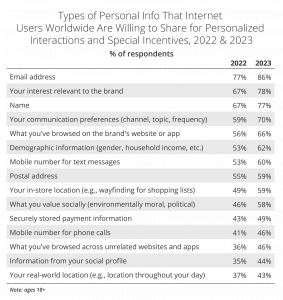In today’s fast-paced retail landscape, building consumer trust has emerged as a pivotal factor for retailers aiming to excel in a competitive market. As price-sensitive consumers become increasingly selective, fostering loyalty through innovative strategies is no longer optional; it is essential.
This is reflected in Gartner’s Brand Trust Survey, where they found that 81% of customers refuse to do business with a brand they don’t trust, and 89% expect to disengage from a brand that breaches their trust. Also a loss of consumer trust can be financially detrimental, with The Economist reporting that it can lead to losses up to 30% of the company’s value.
In these challenging economic times, retailers are becoming increasingly aware of the importance of building consumer trust. But what are the best strategies for building consumer trust? This blog will delve into how retailers can leverage enhanced loyalty programs and ethical business practices, while harnessing artificial intelligence to curate personalized shopping experiences.
By focusing on transparent pricing and ethical business practices, retailers can drive engagement and consumer loyalty, setting themselves apart from the competition. Ultimately, this piece will offer insights into how retailers can not only survive but thrive by building enduring consumer trust.
How Can Retailers Enhance Loyalty Programs?
Customer loyalty programs are strategies to encourage repeat business by rewarding consumers. These programs include points, discounts, offers, or special access to motivate repeat purchases. By offering tangible benefits, loyalty programs foster long-term relationships and enhance customer satisfaction and retention. But how can retailers ensure that they are maximizing their loyalty programs to build consumer trust?
Leveraging First-Hand Data for Improved Customer Experiences
Retailers can significantly enhance loyalty programs by utilizing first-hand data gathered from consumer interactions. As described by Forbes, first-hand data is data collected directly from customer interactions with a company’s products, services or websites, such as transaction history, website visits and engagement with marketing content.
eMarketer have found that customers are more willing than ever to share their data, with 70% of internet users worldwide willing to share their communication preferences for personalized interactions and special incentives. Customers are increasingly willing to share data for personalized interactions and incentives across the board.

This data provides insights into consumer preferences, buying habits, and engagement patterns, enabling retailers to tailor offers and rewards that resonate with their audience. By analyzing consumer data with artificial intelligence (AI), retailers can design personalized promotions that engage customers on a deeper level, thus increasing satisfaction and retention.
9 Strategies Retailers Can Use to Enhance their Loyalty Programs
- Data-Driven Personalization: Leverage data from customer interactions to customize loyalty program offerings. Personalized rewards may include exclusive discounts, early access to new products, or experiences tailored to a customer’s preferences and past purchases, boosting satisfaction and engagement.
- Behavioral Segmented Targeting: Utilize consumer behavior data to effectively segment customers. This enables the development of targeted loyalty campaigns that attract specific demographics or behaviors, ensuring rewards are relevant and appealing to each group. According to McKinsey, behavioral segmentation is far more beneficial than segmenting by needs, value, or demographics and can yield increases of 10 to 20 percent in customer acquisition, 10 to 15 percent in long-term value and retention, and 20 to 30 percent in satisfaction and engagement.
- Predictive Analysis: Apply data for predictive analysis to anticipate customer needs. Foreseeing consumer desires helps retailers craft loyalty programs aligned with future trends, fostering repeated interactions and purchases.
- Feedback Incorporation: Collect and analyze customer feedback to enhance loyalty programs. Insights into customer experiences enable adjustments to better meet expectations, improving satisfaction.
- Omnichannel Personalization: Use data from multiple channels to provide a cohesive and consistent loyalty experience, whether customers are shopping online, in-store, or on a mobile app. This can also extend to communication channels, ensuring that customers receive relevant content through their preferred platform, whether it’s email, social media, or mobile apps. Providing a seamless, personalized experience across channels strengthens customer loyalty.
- Loyalty Tier Adjustments: Analyze engagement and spending data to adjust loyalty tiers in a way that motivates customers to reach higher levels for better rewards, driving repeat purchases.
- Retention Strategies: Use data to identify patterns that lead to customer churn and create targeted strategies, such as special retention offers, to mitigate potential losses.
- Seasonal and Event Offers: Utilize purchasing patterns to develop offers that coincide with seasonal trends and significant life events, making the program more relevant and engaging for customers.
- Real-Time Personalization: Implement dynamic content strategies that use real-time data to adjust the offers and information shown to each customer. This responsive approach makes consumers feel appreciated, boosting trust and loyalty.
Utilizing first-hand data boosts loyalty program efficiency and strengthens consumer trust by understanding and addressing customer needs. Personalization and relevance are key to differentiating a brand in a competitive market. Through AI, personalization can be elevated, providing even deeper connections, and enhancing loyalty. Focusing on unique experiences builds loyal customers who are drawn to brands that cater to their individual preferences. Let’s take a look at how AI can be used in retail for personalization next.
How Can AI Increase Personalization in Retail?
AI is transforming how retailers interact with consumers, creating more engaging and personalized interactions. In an age where consumers have more choice than ever, Forbes describe AI as helping to address the “choice overload” phenomena where individuals report lower choice satisfaction when faced with too many options. By leveraging AI, retailers can analyze vast amounts of consumer data to deliver highly tailored shopping experiences. These innovations cater to individual preferences and provide a more immersive shopping experience, which can increase consumer satisfaction and loyalty.
8 Ways AI Can Enhance Personalization for Consumers in the Retail Industry
1. Predictive Analytics for Enhanced Consumer Engagement and Satisfaction
AI algorithms can predict consumer preferences, suggest products, and personalize marketing efforts based on individual behaviors and past interactions. This level of personalization increases consumer engagement and satisfaction, as customers feel understood and valued by the brand. According to global research and analytics company, Reso, the level of personalization being used by Amazon is proving effective in retaining consumer interest, with their bounce rate of 35% notably lower than competitors Walmart (50%) and Target (45%), highlighting the power of predictive analytics.
2. Dynamic Pricing
AI also enables dynamic pricing strategies, helping retailers optimize pricing based on demand, inventory levels, and competitor pricing. According to Forbes, the adoption of AI for dynamic pricing offers four main benefits for businesses:
- Companies can use AI to optimize pricing for peak demand and adjust during off-peak periods to maintain sales.
- AI ensures competitive pricing by quickly reacting to market changes.
- It tailors prices for customer segments based on sensitivity, enhancing sales and satisfaction.
- Dynamic pricing efficiently manages inventory, reducing stockouts and excesses in low demand periods.
3. Enhanced Customer Service
AI significantly enhances customer service in the retail industry by providing personalized experiences through AI-driven chatbots and virtual assistants. These technologies provide real-time support, handle inquiries, and suggest products based on preferences, enhancing online and in-store satisfaction.
4. Augmented Reality (AR) Experiences
AI-powered AR can create immersive shopping experiences, allowing consumers to explore products in a personalized virtual environment, increasing engagement and conversion rates. AI enables virtual try-ons, letting customers visualize products on themselves to personalize their shopping experience before buying.
5. Sentiment Analysis
AI can analyze consumer reviews and feedback to gauge sentiment, allowing retailers to refine their offerings and improve the shopping experience, catering to consumer preferences.
6. Recommendation Systems
AI utilizes collaborative filtering and data analysis to suggest products consumers are likely to appreciate, boosting sales through highly tailored recommendations.
7. Customer Journey Mapping
AI can track and analyze the customer journey across all touchpoints, allowing retailers to personalize interactions at each stage, enhancing satisfaction and loyalty.
8. Inventory and Supply Chain Optimization
Through AI, retailers can personalize stock recommendations and ensure that products are available based on consumer preferences in different regions, enhancing the overall shopping experience.
AI-powered personalization helps retailers stand out with seamless shopping experiences that build trust, foster connections, and drive loyalty.
The Importance of Ethical Business Practices
Building Consumer Trust
Building consumer trust is central to ethical business practices. Gartner describes brand trust as a customer’s confidence in a company consistently fulfilling its promises, even during challenging times. Retailers earn trust by being reliable, honest, and transparent—delivering high product quality, meeting promises, and providing correct information.
Clear communication, addressing inquiries promptly, and maintaining transparency in policies are essential. Trust is reinforced through ethical sourcing, sustainability efforts, and protecting consumer data, especially in the digital era. Reliable brands enjoy greater loyalty, repeat purchases, and word-of-mouth endorsements, essential for long-term success. A vital element in building trust within the retail sector is transparent pricing.
Importance of Transparent Pricing
Transparent pricing is crucial in establishing consumer trust and fostering loyalty in the retail sector. When retailers are open about their pricing structures, they demonstrate integrity and respect for their customers, leading to stronger relationships. Transparent pricing involves three important things:
- Clear communication of costs
- Avoiding hidden fees
- Ensuring that discounts and promotions are straightforward and easy to understand
This approach helps reduce consumer skepticism, especially in an age where misinformation is rampant. Transparency in pricing differentiates a brand in a crowded market, as consumers can easily compare prices online. Retailers prioritizing transparent pricing are seen as more trustworthy, which boosts customer loyalty and word-of-mouth referrals. By adopting such pricing strategies, retailers adhere to ethical practices and gain a competitive edge, leading to sustained growth and an enhanced reputation.
How AP Automation Helps Retailers Build Consumer Trust
SoftCo supports retail clients like Superdry, Primark, and Logitech in building consumer trust by providing robust, data-driven solutions that empower retailers to streamline operations and focus on customer-centric initiatives. SoftCoP2P for Retail enables retailers to digitize their Accounts Payable (AP) departments through automation, which is crucial for creating efficient, transparent payment processes and gaining real-time visibility into financial operations.
Through AP automation, retailers can significantly reduce manual tasks and improve the speed and accuracy of invoice processing. This streamlined approach enhances cash flow management and allows retailers to shift resources towards strategic efforts, such as loyalty programs, personalized offers, and customer engagement. Furthermore, AP automation supports retailers’ ability to implement AI-driven initiatives like dynamic pricing and inventory optimization by providing timely insights into cash flow and procurement. Optimizing these areas enables retailers to adjust prices in real-time, manage stock better, and respond to consumer demands with agility.
Additionally, SoftCo’s automation solutions for retail ensure that procurement practices align with ethical and transparent standards, enabling retailers to track product origins and promote sustainability. With SoftCo’s AP automation, retailers boost efficiency and build consumer trust through transparent, ethical practices, standing out competitively.


